青少版新概念英语课件1B_Unit16(共44页)
文档属性
| 名称 | 青少版新概念英语课件1B_Unit16(共44页) |  | |
| 格式 | ppt | ||
| 文件大小 | 8.7MB | ||
| 资源类型 | 试卷 | ||
| 版本资源 | 新概念英语 | ||
| 科目 | 英语 | ||
| 更新时间 | 2022-09-20 17:44:23 | ||
图片预览

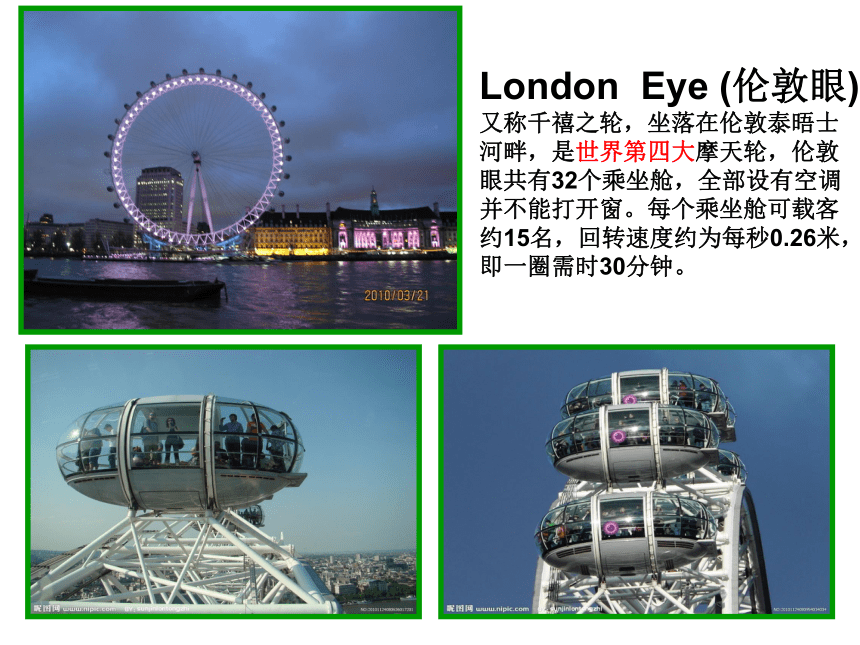

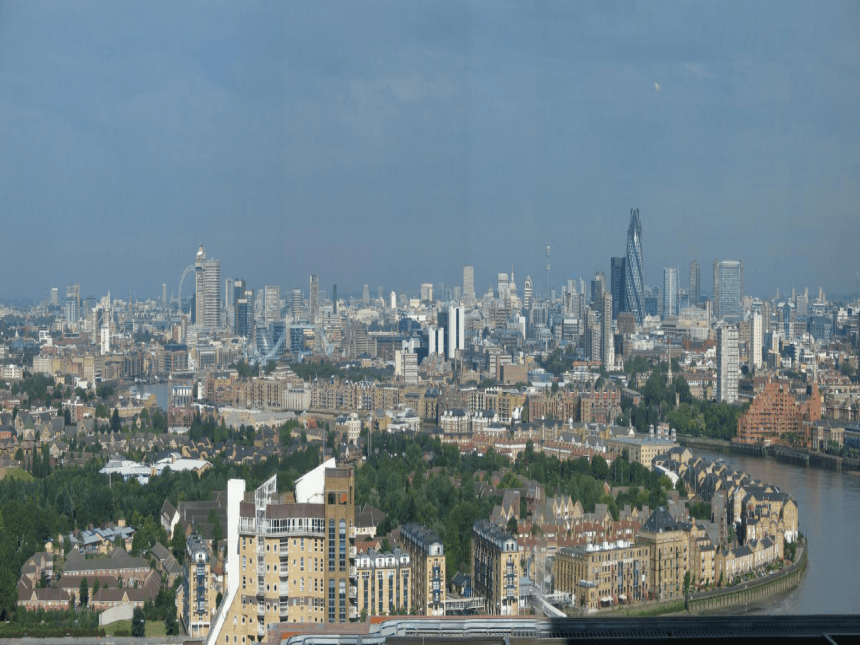
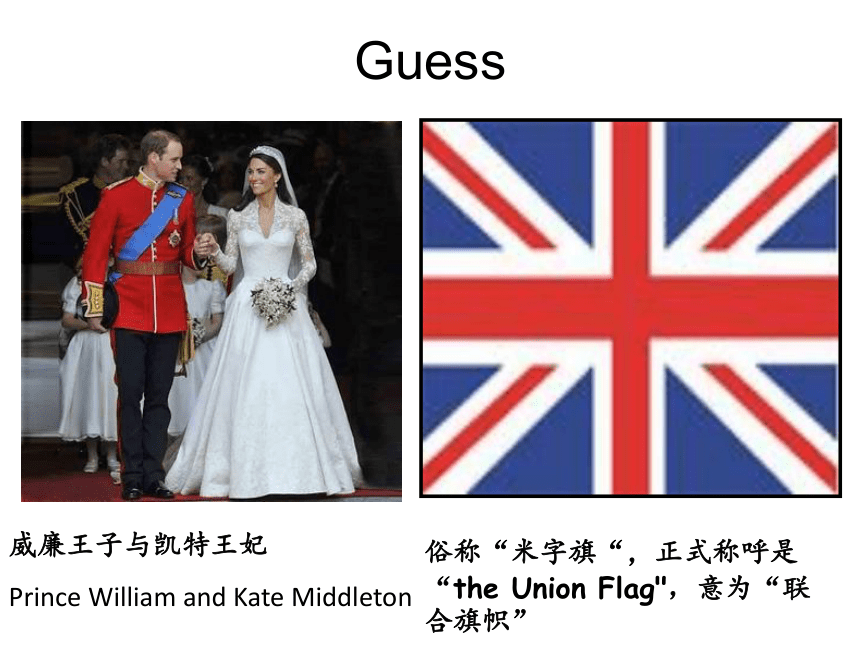
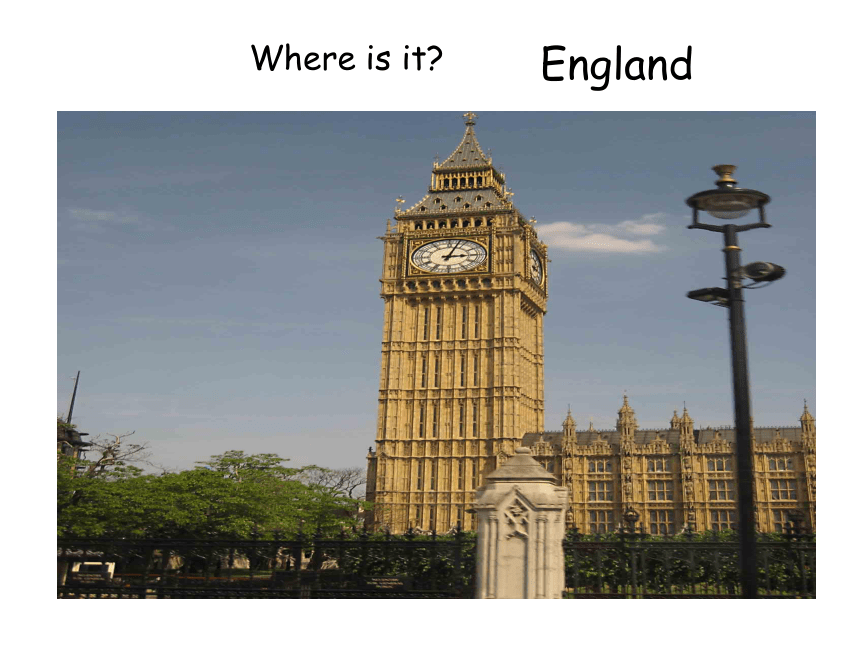
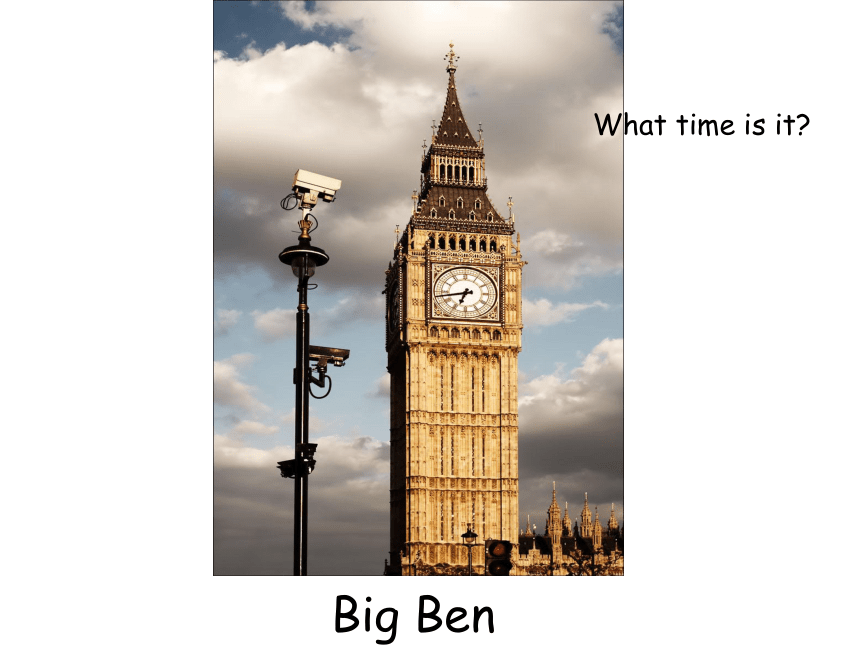
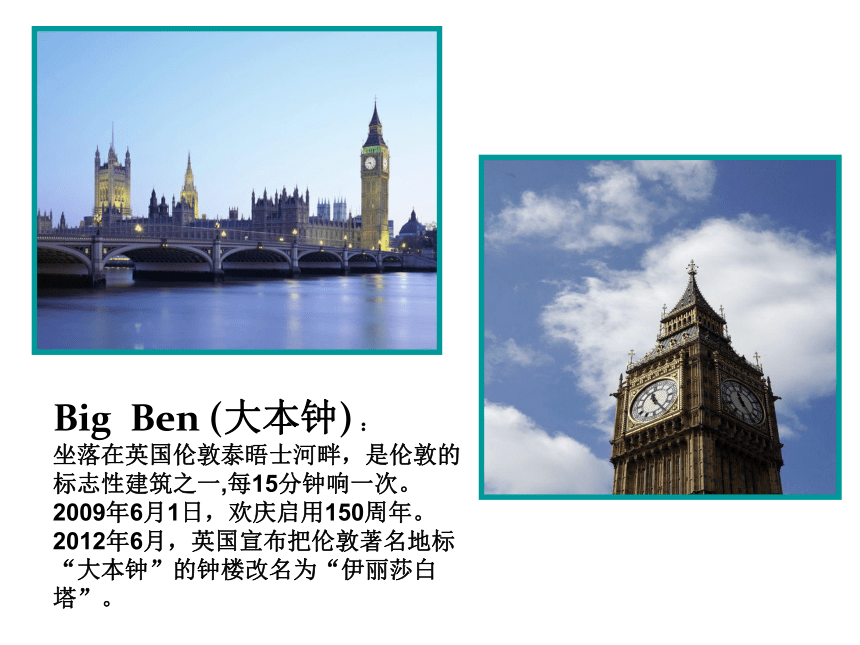
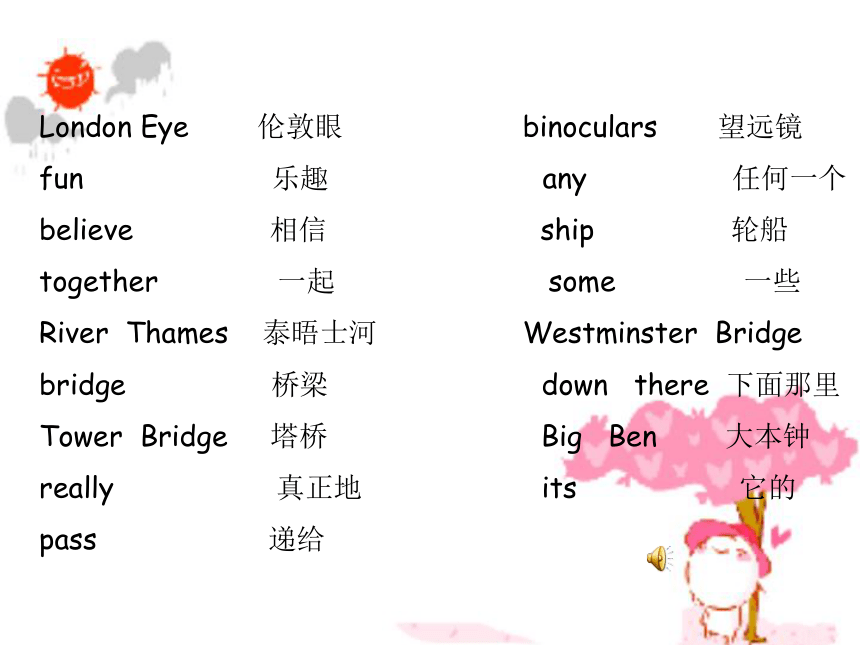


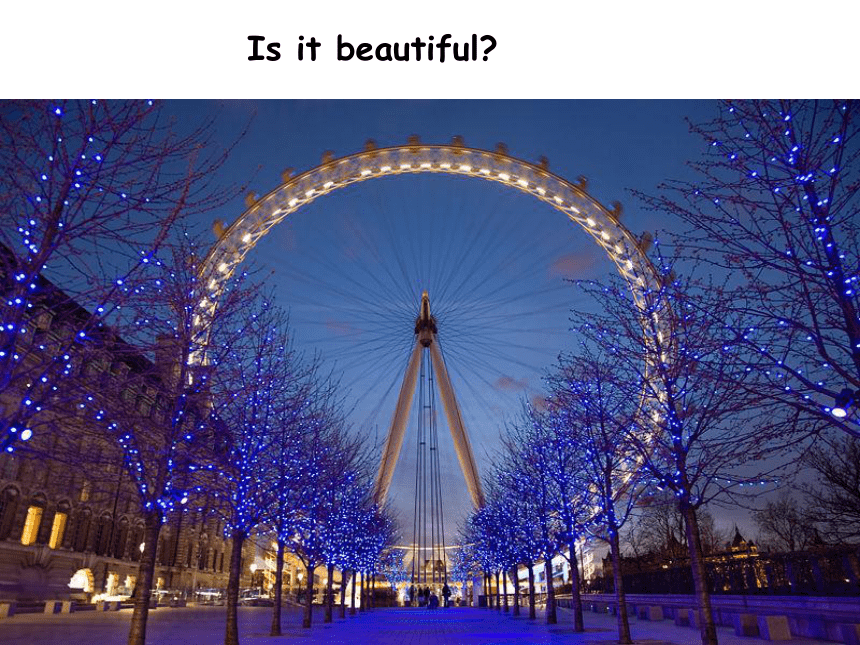
文档简介
(共44张PPT)
London Eye (伦敦眼)又称千禧之轮,坐落在伦敦泰晤士河畔,是世界第四大摩天轮,伦敦眼共有32个乘坐舱,全部设有空调并不能打开窗。每个乘坐舱可载客约15名,回转速度约为每秒0.26米,即一圈需时30分钟。
Which city is the the capital of UK (The United Kingdom of Great Britain and Northern Ireland)
London
Guess
威廉王子与凯特王妃
Prince William and Kate Middleton
俗称“米字旗“,正式称呼是“the Union Flag",意为“联合旗帜”
Where is it
England
Big Ben
What time is it
Big Ben (大本钟) :
坐落在英国伦敦泰晤士河畔,是伦敦的标志性建筑之一,每15分钟响一次。2009年6月1日,欢庆启用150周年。2012年6月,英国宣布把伦敦著名地标“大本钟”的钟楼改名为“伊丽莎白塔”。
London Eye 伦敦眼 binoculars 望远镜
fun 乐趣 any 任何一个
believe 相信 ship 轮船
together 一起 some 一些
River Thames 泰晤士河 Westminster Bridge
bridge 桥梁 down there 下面那里
Tower Bridge 塔桥 Big Ben 大本钟
really 真正地 its 它的
pass 递给
Q:What can they see on Westminster Bridge
Listen to the tape and answer the following questions:
They can see some people, some cars and some buses
on Westminster Bridge.
London Eye
Is it beautiful
Daisy: Oh, Jack! Isn’t this fun Can you believe
it We’re all together on the London Eye!
1、
Daisy
Jack
Jack: Yes, honey. Isn’t it great Look, Claire! That’s the River Thames.
Claire: Yes, Dad. Isn’t it grey
Daisy: Well, grey and silver! It’s beautiful. Look at all the bridges!
2、
Claire
River Thames
Q:What color is the river
It’s grey and silver.
Claire: Hey, Mom, I can see Tower Bridge. It’s open.
Jack: Is it really Pass me the binoculars!
3、
Give me / show me
双宾语动词短语
间接宾语
直接宾语
关于双宾语结构
1.也就是一个动词后面出现了两个动作的承受者,一个表示人的,而另一个表示物的。其中表示人的宾语叫间接宾语,而表示物的叫直接宾语。
2.一般在句子中的结构是:
主语+动词+间接宾语(人)+直接宾语(物)
eg: They gave him a watch.
这里的him 是间接宾语, a watch 是直接宾语
3.但是有的时候,我们在句子中可以把两种宾语调换位置。通常要用介词to或for引起的短语.
用to侧重指动作的方向,表示朝着,向着,对着某人
用for 侧重指动作的受益者,表示为了某人,替某人。
常跟双宾语的动词有:
(需借助to的)bring, give, lend, hand, offer, pass, pay, promise, return, send, show, teach, tell, write, ask,等。
(需借助for 的) buy, call, cook, choose, draw, find, get, make, order, sing, save, spare,等
※ 如果表示物的宾语是宾格代词,这时候只能用
主语+动词+直接宾语(物)+ to+间接宾语(人)
eg: Please give it to me. 请把它给我。
Tower Bridge
Is it open or shut
Tower Bridge is open.
Jack: Can you see any ships there
Claire: I can see one. There are some boats, too.
4、
指不确定的数量
代词;指代“ one ship ”
Daisy: Look, Jack! That’s Westminster Bridge down there. There are some people on the bridge.
Jack: There are some cars and buses, too.
5、
Westminster Bridge
What can you see on the Westminster Bridge
people
Claire: Hey, Dad! That’s Big Ben! It’s twelve o’clock!
Daisy: Ding-dong, ding-dong; Ding-dong, ding-dong! Oh, Jack! Isn’t London just great
6、
Daisy:Oh, Jack!Isn’t this ___ Can you ____it We’re all ______ on the London Eye!
Jack:Yes,honey.Isn’t it ____ Look,Claire!That’s the ____ ____.
Claire:Yes,Dad.Isn’t it ___
Daisy:Well,___ and _____!It’s ______.Look at all the ______!
Claire:Hey,Mom,I can see Tower Bridge. It’s ____!
Jack:Is it ____ Pass me the ______!
Jack:Can you see ___ ships there
Claire:I can see ____.There are some___,too
Daisy: Look,Jack! That’s Westminster Bridge ____ there.There are some ____ on the____.
Jack:___ ____ some cars and ___ ,too.
Claire:Hey,Dad!That’s ___ ___!It’s ____ o’clock!
Daisy: Ding-dong, ding-dong; Ding-dong,ding-dong!Oh,Jack! Isn’t London____ ___
fun
believe
together
great
River Thames
grey
grey silver
beautiful
bridges
open
really
binoculars
any
one
boats
down
people
bridge
There are
buses
Big Ben
twelve
just great
Unit 16
------Lesson 32
1、Pronunciation
2、Grammar
Pronunciation
/f/
fun football field fair front referee outfit fifty nephew
/v/
very clever silver river heavy five seven eleven twelve
/v/是浊辅音,声带振动。
church
classroom
park
cinema
1)国名,人名前通常不用定冠词:England,Mary;
2)泛指的复数名词,表示一类人或事物时,可不用定冠词;
They are teachers. 他们是教师。
3)抽象名词表示一般概念时,通常不加冠词;
Failure is the mother of success. 失败乃成功之母。
4)物质名词表示一般概念时,通常不加冠词,当表示特定的意思时,需要加定冠词;
Man cannot live without water. 人离开水就无法生存。
5)在季节、月份、节日、 假日、日期、星期等表示时间的名词之前,不加冠词;
We go to school from Monday to Friday.
我们从星期一到星期五都上课。
6)在称呼或表示官衔,职位的名词前不加冠词;
The guards took the American to General Lee.
士兵们把这个美国人送到李将军那里。
英语中哪些情况在名词前不用加冠词
7)在三餐、球类运动和娱乐运动的名称前,不加冠词 如:have breakfast,play chess
8)当两个或两个以上名词并用时,常省去冠词;
I can't write without pen or pencil.
没有钢笔和铅笔,我就写不了字。
9)当by 与火车等交通工具连用,表示一种方式时,中间无冠词;by bus,by train;
10)有些个体名词不用冠词;如:school,college,prison,market,hospital,bed,table,class,town,church,court 等个体名词,直接置于介词后,表示该名词的深层含义;
go to hospital 去医院看病
go to the hospital 去医院 (并不是去看病,而是有其他目的)
some 和 any 的用法
共同点;some和any 表一些,都可以修饰可数和不可数名词。
不同点;1.some 一般用于肯定句。
2. any 一般用于疑问句和否定句。
3.Some 有时用于疑问句,表达得到肯定回答,并不表示对某事疑问。
Eg; Can you give me some milk
on
in
under
in front of
behind
near / beside
in,in 在里面,
on,on 在上面,
under,under 在下面,
in front of 在前面,
behind, behind 在后面,
在附近,在旁边,near 还有beside
介词口诀
Are there any children in the classroom
Yes, there are.
Are there any children in the park
No, there aren’t.
children
in the classroom
not in the park
Are there any …
Yes, there are.
Are there any …
No, there aren’t.
Can you see any children
Yes, I can. There are some children in the classroom.
Can you see any children in the park
No, I can’t, but I can see some children in the classroom.
children
in the classroom
not in the park
Can you see any …
Yes, I can. There are some…
Can you see any …
No, I can’t, but I can see some…
Homework:
1、完成书后P8(2/3),P9选择填空;
2、熟练拼读本课所勾单词;
3、熟练朗读本课对话,下周检查已学部分;
4、开口跟读光碟,预习课文对话;
London Eye (伦敦眼)又称千禧之轮,坐落在伦敦泰晤士河畔,是世界第四大摩天轮,伦敦眼共有32个乘坐舱,全部设有空调并不能打开窗。每个乘坐舱可载客约15名,回转速度约为每秒0.26米,即一圈需时30分钟。
Which city is the the capital of UK (The United Kingdom of Great Britain and Northern Ireland)
London
Guess
威廉王子与凯特王妃
Prince William and Kate Middleton
俗称“米字旗“,正式称呼是“the Union Flag",意为“联合旗帜”
Where is it
England
Big Ben
What time is it
Big Ben (大本钟) :
坐落在英国伦敦泰晤士河畔,是伦敦的标志性建筑之一,每15分钟响一次。2009年6月1日,欢庆启用150周年。2012年6月,英国宣布把伦敦著名地标“大本钟”的钟楼改名为“伊丽莎白塔”。
London Eye 伦敦眼 binoculars 望远镜
fun 乐趣 any 任何一个
believe 相信 ship 轮船
together 一起 some 一些
River Thames 泰晤士河 Westminster Bridge
bridge 桥梁 down there 下面那里
Tower Bridge 塔桥 Big Ben 大本钟
really 真正地 its 它的
pass 递给
Q:What can they see on Westminster Bridge
Listen to the tape and answer the following questions:
They can see some people, some cars and some buses
on Westminster Bridge.
London Eye
Is it beautiful
Daisy: Oh, Jack! Isn’t this fun Can you believe
it We’re all together on the London Eye!
1、
Daisy
Jack
Jack: Yes, honey. Isn’t it great Look, Claire! That’s the River Thames.
Claire: Yes, Dad. Isn’t it grey
Daisy: Well, grey and silver! It’s beautiful. Look at all the bridges!
2、
Claire
River Thames
Q:What color is the river
It’s grey and silver.
Claire: Hey, Mom, I can see Tower Bridge. It’s open.
Jack: Is it really Pass me the binoculars!
3、
Give me / show me
双宾语动词短语
间接宾语
直接宾语
关于双宾语结构
1.也就是一个动词后面出现了两个动作的承受者,一个表示人的,而另一个表示物的。其中表示人的宾语叫间接宾语,而表示物的叫直接宾语。
2.一般在句子中的结构是:
主语+动词+间接宾语(人)+直接宾语(物)
eg: They gave him a watch.
这里的him 是间接宾语, a watch 是直接宾语
3.但是有的时候,我们在句子中可以把两种宾语调换位置。通常要用介词to或for引起的短语.
用to侧重指动作的方向,表示朝着,向着,对着某人
用for 侧重指动作的受益者,表示为了某人,替某人。
常跟双宾语的动词有:
(需借助to的)bring, give, lend, hand, offer, pass, pay, promise, return, send, show, teach, tell, write, ask,等。
(需借助for 的) buy, call, cook, choose, draw, find, get, make, order, sing, save, spare,等
※ 如果表示物的宾语是宾格代词,这时候只能用
主语+动词+直接宾语(物)+ to+间接宾语(人)
eg: Please give it to me. 请把它给我。
Tower Bridge
Is it open or shut
Tower Bridge is open.
Jack: Can you see any ships there
Claire: I can see one. There are some boats, too.
4、
指不确定的数量
代词;指代“ one ship ”
Daisy: Look, Jack! That’s Westminster Bridge down there. There are some people on the bridge.
Jack: There are some cars and buses, too.
5、
Westminster Bridge
What can you see on the Westminster Bridge
people
Claire: Hey, Dad! That’s Big Ben! It’s twelve o’clock!
Daisy: Ding-dong, ding-dong; Ding-dong, ding-dong! Oh, Jack! Isn’t London just great
6、
Daisy:Oh, Jack!Isn’t this ___ Can you ____it We’re all ______ on the London Eye!
Jack:Yes,honey.Isn’t it ____ Look,Claire!That’s the ____ ____.
Claire:Yes,Dad.Isn’t it ___
Daisy:Well,___ and _____!It’s ______.Look at all the ______!
Claire:Hey,Mom,I can see Tower Bridge. It’s ____!
Jack:Is it ____ Pass me the ______!
Jack:Can you see ___ ships there
Claire:I can see ____.There are some___,too
Daisy: Look,Jack! That’s Westminster Bridge ____ there.There are some ____ on the____.
Jack:___ ____ some cars and ___ ,too.
Claire:Hey,Dad!That’s ___ ___!It’s ____ o’clock!
Daisy: Ding-dong, ding-dong; Ding-dong,ding-dong!Oh,Jack! Isn’t London____ ___
fun
believe
together
great
River Thames
grey
grey silver
beautiful
bridges
open
really
binoculars
any
one
boats
down
people
bridge
There are
buses
Big Ben
twelve
just great
Unit 16
------Lesson 32
1、Pronunciation
2、Grammar
Pronunciation
/f/
fun football field fair front referee outfit fifty nephew
/v/
very clever silver river heavy five seven eleven twelve
/v/是浊辅音,声带振动。
church
classroom
park
cinema
1)国名,人名前通常不用定冠词:England,Mary;
2)泛指的复数名词,表示一类人或事物时,可不用定冠词;
They are teachers. 他们是教师。
3)抽象名词表示一般概念时,通常不加冠词;
Failure is the mother of success. 失败乃成功之母。
4)物质名词表示一般概念时,通常不加冠词,当表示特定的意思时,需要加定冠词;
Man cannot live without water. 人离开水就无法生存。
5)在季节、月份、节日、 假日、日期、星期等表示时间的名词之前,不加冠词;
We go to school from Monday to Friday.
我们从星期一到星期五都上课。
6)在称呼或表示官衔,职位的名词前不加冠词;
The guards took the American to General Lee.
士兵们把这个美国人送到李将军那里。
英语中哪些情况在名词前不用加冠词
7)在三餐、球类运动和娱乐运动的名称前,不加冠词 如:have breakfast,play chess
8)当两个或两个以上名词并用时,常省去冠词;
I can't write without pen or pencil.
没有钢笔和铅笔,我就写不了字。
9)当by 与火车等交通工具连用,表示一种方式时,中间无冠词;by bus,by train;
10)有些个体名词不用冠词;如:school,college,prison,market,hospital,bed,table,class,town,church,court 等个体名词,直接置于介词后,表示该名词的深层含义;
go to hospital 去医院看病
go to the hospital 去医院 (并不是去看病,而是有其他目的)
some 和 any 的用法
共同点;some和any 表一些,都可以修饰可数和不可数名词。
不同点;1.some 一般用于肯定句。
2. any 一般用于疑问句和否定句。
3.Some 有时用于疑问句,表达得到肯定回答,并不表示对某事疑问。
Eg; Can you give me some milk
on
in
under
in front of
behind
near / beside
in,in 在里面,
on,on 在上面,
under,under 在下面,
in front of 在前面,
behind, behind 在后面,
在附近,在旁边,near 还有beside
介词口诀
Are there any children in the classroom
Yes, there are.
Are there any children in the park
No, there aren’t.
children
in the classroom
not in the park
Are there any …
Yes, there are.
Are there any …
No, there aren’t.
Can you see any children
Yes, I can. There are some children in the classroom.
Can you see any children in the park
No, I can’t, but I can see some children in the classroom.
children
in the classroom
not in the park
Can you see any …
Yes, I can. There are some…
Can you see any …
No, I can’t, but I can see some…
Homework:
1、完成书后P8(2/3),P9选择填空;
2、熟练拼读本课所勾单词;
3、熟练朗读本课对话,下周检查已学部分;
4、开口跟读光碟,预习课文对话;
同课章节目录
- Unit 16 On the London Eye
- Unit 17 Smile,please!
- Unit 18 Men can cook,too!
- Unit 19 You must eat!
- Unit 20 What a surprise!
- Unit 21 Breakfast blues
- Unit 22 Watching the neighbours
- Unit 23 An expensive camera
- Unit 24 A light dinne
- Unit 25 The weekend shopping
- Unit 26 A self-service restaurant
- Unit 27 Toothache
- Unit 28 Every day is different!
- Unit 29 Many happy returns of the day!
- Unit 30 An internation event
